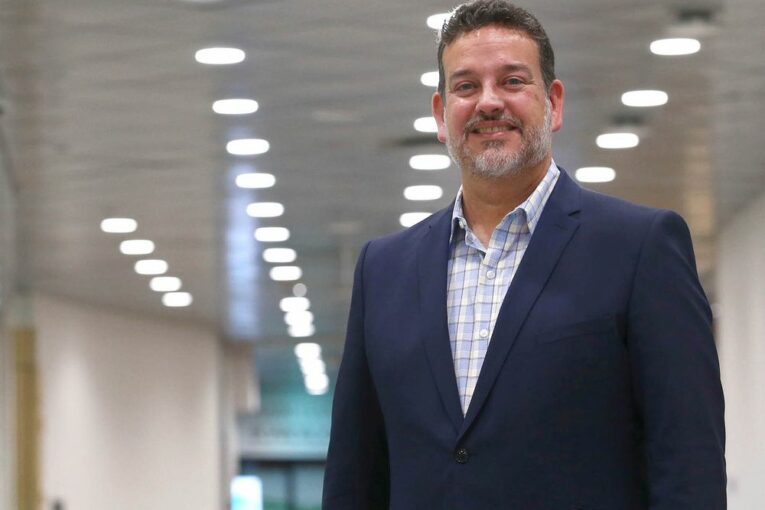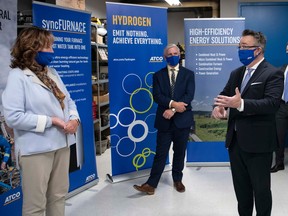
The Alberta Federation of Labour said there are 200,000 jobs and billions of dollars at stake in transitioning and diversifying the economy but questioned the province’s commitment to doing so.
Gil McGowan, president of the AFL, released a report on Wednesday — “Skate to Where the Puck is Going: An industrial blueprint for job creation” — which lays out seven strategies he said should be incorporated into the energy transition to protect and create jobs in a green economy.
However, he questioned whether new Premier Danielle Smith has positioned herself to do the job, pointing to what he called a vague plan for diversifying the economy and reaching 2050 net-zero promises.
“She’s moved from climate denial to parroting talking points from the most backward-looking elements of Alberta’s oil and gas establishment,” he said. “She’s not talking to what I think is a majority of Albertans in the business community and the majority of Albertans across the province who actually understand that change is coming and that we have to prepare for it, and who also understand that change actually presents opportunities, not just threats.”
The plan from the AFL calls on the province to take cues from former Progressive Conservative premier Peter Lougheed and his insistence gas companies strip off natural gas liquids before they could be exported, which has paved the way for the province’s multibillion-dollar petrochemical industry. He said the government, not private industry, should be taking the lead on developing the energy transition, de-risking the investment and keeping revenues in the province.

A number of the points in the report have been backed up by such other organizations as Calgary Economic Development and the Business Council of Alberta on matters of diversification and transitioning to greener energy. Technologies currently under development in Alberta like hydrogen and sustainable fuel for airplanes need to be scaled up while further investment in producing bitumen for product creation as opposed to burning for fuel — thus maintaining jobs in the oil patch and putting Alberta at the forefront of this evolution — needs to be part of the province’s path forward.
The report also said Alberta will need to “double or triple” its electrical grid capacity by 2050 to handle the demands of industry and transportation. This can be done through further diversification of the sector with more renewable investment in solar, wind and geothermal. It also said Alberta needs to proceed with small nuclear reactors. The province has signed a memorandum of understanding to help develop the technology with other provinces.
The timing of this is critical, according to the report, so as not to be left behind by the U.S. with its Inflation Reduction Act, recently signed in by President Joe Biden, part of which aims to develop domestic energy production and promote cleaner sources of energy.
Charles St-Arnaud, chief economist for Alberta Central, said timing is of the essence for these types of shifts.
“The problem I find is, are we playing our card well enough, early enough?” he said. “The question with the whole energy transition, and when you have big, structural economic change, is that either you are an early adopter and you decide how you want to do it, or you’re a late adopter and then you get forced into taking the crumbs of what’s left.”
He said with oil and gas demand set to peak in 2030, diversification of the sector and our economy is important now to better soften the blow of the fall a decade from now.
McGowan said the report is a plan forward that does not sacrifice jobs or economic growth, but instead grows both. He also said the provincial and federal governments need to be on board for this to happen, and that Ottawa needs the province to partner in this.
Federal Natural Resources Minister Jonathan Wilkinson was in Calgary last week talking about this shift to green energy but was light on details, particularly surrounding plans for a Just Transition which would ensure the continuity of jobs, as well as Indigenous and municipal involvement.
The federal government will release the second phase of its Regional Energy and Resource Tables on Thursday to include New Brunswick, Nova Scotia, P.E.I, Northwest Territories and Yukon. The tables outline collaborative efforts to advance top economic priorities in the natural resource space for every region of Canada. Engagement with the provinces began on June 1, though former premier Jason Kenney declined to be a part of those negotiations due to his time in office ending. Ostensibly, Alberta will be part of the third phase of this program.
Recommended from Editorial
-

Alberta government’s Hydrogen Roadmap accelerates goal of exporting globally by 10 years
-

Varcoe: Nuclear power could be ‘holy grail’ for oilsands, says Cenovus CEO
The Office of Natural Resources said it had been in discussions with Alberta on other initiatives previously.
“The federal government is committed to building a clean, prosperous economy — one that creates sustainable jobs for people and communities in every province and territory,” said Keean Nembhard, press secretary for Wilkinson in an email. “Canada has the resources and expertise to thrive in the global net-zero economy, and we are focused on making Canada the global supplier of choice for clean technology and energy in a net-zero world.”
The province did not respond to interview requests prior to publication.
Twitter: @JoshAldrich03
You can read more of the news on source

